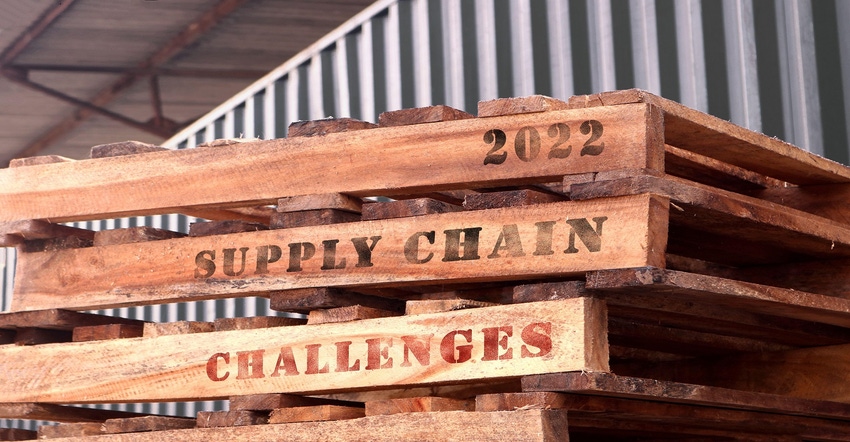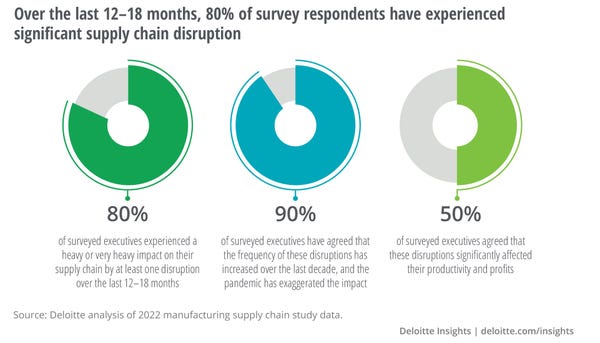Fixing the Broken Supply Chain
In the post-pandemic era, strong supplier relationships have become critical for manufacturers. Here are some ideas on how to build a strong supplier network to keep inventory under control.
December 28, 2022

The past two years have demonstrated that the familiar formula of minimizing costs and maximizing efficiency in global supply chains is no longer enough. The system of just-in-time inventory failed miserably. Now, supply chain analysts insist that redundancy and resilience should be added to the equation to decrease supply chain disruptions.
To gauge the impact of these disruptions, Deloitte and Manufacturers Alliance surveyed more than 200 manufacturing executives over the past 18 months and produced the study, Meeting the Challenge of Supply Chain Disruption. The report examines how traditional manufacturing supply chains are evolving to balance costs, efficiency, and resilience.
The results indicated that 80% of respondents have experienced a heavy supply chain disruption in the previous 12-18 months. The disruptions include shipping delays, part shortages, and transportation delays due to truck driver shortages and congested ports. Other manufacturers are facing operational concerns when trying to fulfill contracts including rising costs (46%), product issues from suppliers struggling to meet demand (43%), and logistical challenges when implementing new supply chains or contingency planning approaches (43%).

To address these issues, manufacturers are turning to strategies in the following four key areas.
Strengthening existing relationships. According to the study, among the top operational concerns for manufacturers right now are product issues from suppliers struggling to meet demand (44%). To mitigate this, 83% are investing in their existing supplier relationships as part of their overall supply chain investments.
Diversification of supply chains. While still investing in existing relationships, 81% of manufacturing executives are also working to engage multiple suppliers. However, regional diversification of suppliers is less common. Cost (43%) is the primary concern.
Implementing digital solutions. While manufacturers see value in the digitalization of their supply chains – 78% agree using digital solutions and/or monitoring tools would enhance visibility and transparency through the supply network, and 76% plan to do so – 88% say they are concerned about legal, financial, privacy, IP theft or cybersecurity due to the digitization of supply chain ecosystems.
Returning to a just-in-case inventory approach. Nearly two-thirds of manufacturing executives (65%) are, at least temporarily, shifting from a just-in-time approach that capitalizes on lean inventory investment to a just-in-case approach to mitigate any upcoming issues.
We caught up with Paul Wellener, vice chair of US Industrial Products & Construction at Deloitte. He offered further details on the four points outlined by the study.
Design News: What is involved in strengthening existing supplier relationships? What can manufacturers do that they are not already doing with their suppliers?
Paul Wellener: A couple of things. Strengthening needs to take place in all aspects of the supplier relationships. The top of the house is talking to the top of the house. Yet the communication needs to improve down the line. We have a relatively young workforce with maybe one to three years of experience. Two of those years of experience have been in the pandemic.
They haven’t had the time to build supplier relationships. That needs to take place across all levels. That includes the need for mentoring and growing the procurement function. This has been driven by two years of Zoom calls. These people haven’t been able to have dinner. You need to make things easier for the supplier by improving the relationship with better communication.
DN: What does diversification of suppliers mean? Is it geographic? Engaging the competitors of existing suppliers?
Paul Wellener: In the world of lean, manufacturers have been taking weight out of the system, taking out time, taking out costs. The notion of pursuing multiple suppliers is not just looking for more suppliers, it’s creating other suppliers, giving an existing supplier new space, and stepping outside the existing supply base. It’s partly geographic. Suppliers need to be closer to your production. Think about being closer to the supplier. There is going to be tension in the system, especially now with shortages of supply. So you have to make sure you don’t tick off your suppliers.
DN: How do manufacturers overcome security concerns when extending digital connections to suppliers?
Paul Wellener: Cybersecurity is a big topic. As we become more connected, there is a greater focus on cybersecurity and becoming more resilient. No one can avoid all attacks. Plus, you have to recover quickly from an attack. You have to work with existing suppliers to fortify their security, and when you bring in new suppliers, you have to make sure they are up to the security requirements. You have to look at the entire supply chain with cyber concerns, especially when you have multi-tier suppliers
DN: Do you see just-in-case inventory as a temporary or permanent shift from just-in-time?
Paul Wellener: It’s a pendulum. We centralize and then decentralize. We pushed the supply chain hard to just in time. Then the supply chain faced a crisis that stretched the just-in-time to the breaking point. That problem was not taken lightly. There was inventory in the system, but manufacturers had to look at where their inventory needed to be. They needed more of the right inventory, not more of the wrong inventory.
The labor shortages, congested ports, and truck driver shortages made things worse. Now we have to look at just-in-case inventory to create a strategic buffer. In the near term, manufacturers won’t pivot back to pre-pandemic inventory levels. That’s inventory management – thinking about the lost opportunity versus the cost of carrying excess inventory. It’s a matter of providing good customer service at the right cost.
About the Author(s)
You May Also Like





